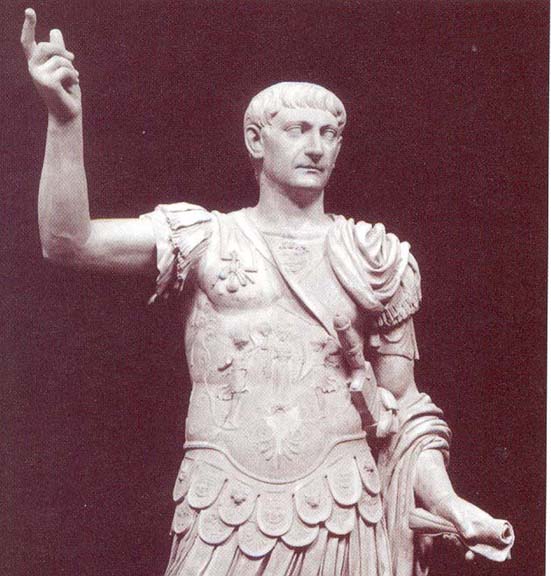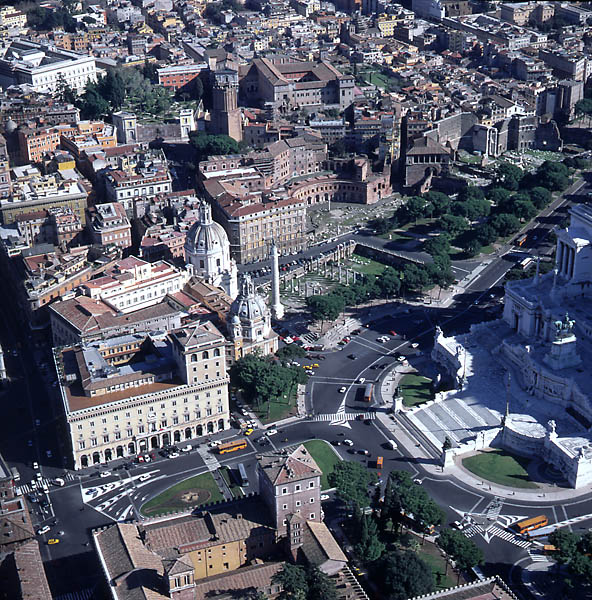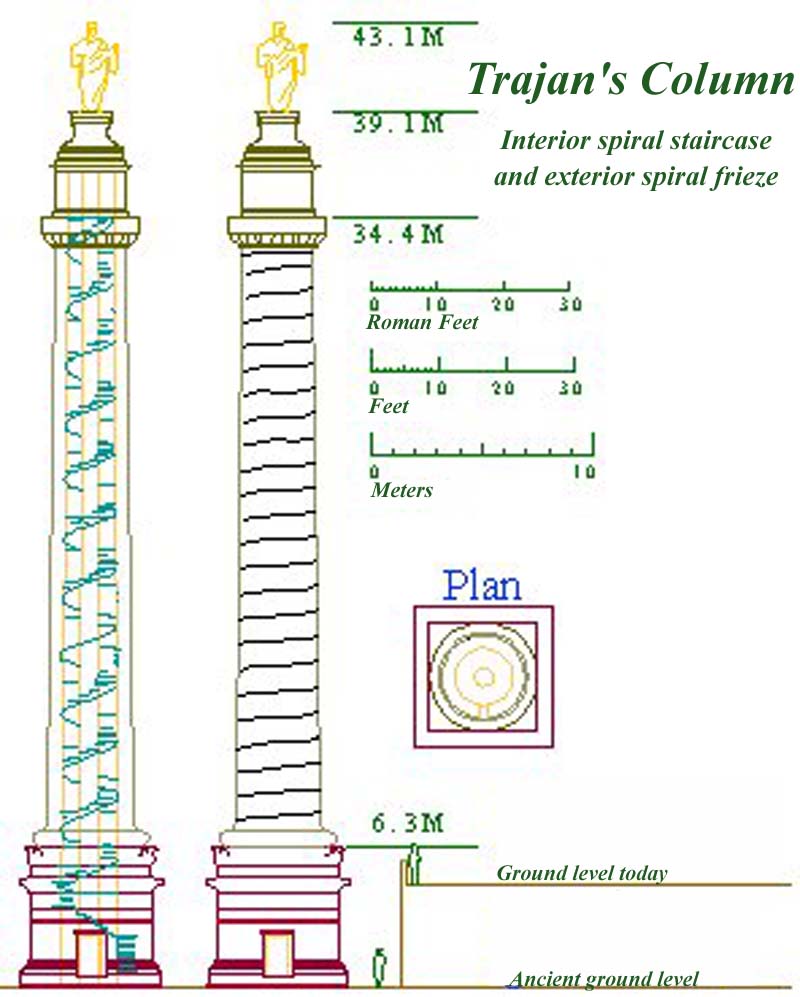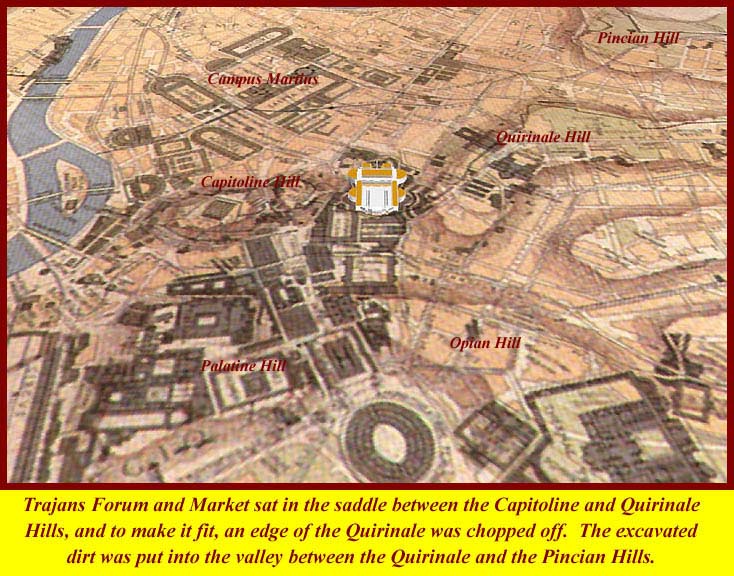

Trajan and His Column


The Daci: Augustus had claimed them as tributary allies, but they didn't pay much attention to his claim and seldom paid the tribute. Vespasian's second son, Domitian, set out to collect the back dues after his much more popular older brother, Titus, died in his first year as emperor. But he had to pull back his legions when trouble erupted elsewhere in the north, and he signed an ignoble treaty -- Rome ended up paying tribute. Finally, eleven years later in 101 AD, Trajan led his first campaign across he Danube and through dense forests and fought the Daci (pronounced DOT-chee) on the Transylvanian plateau for a year and a half (Trans Silvania meant "through the forests" in Latin.) Three years later he came back to finished the job, and he made the whole area, all the way up into the Carpathian Mountains, a Roman province by 107 AD. Trajan repopulated the new province with hordes of Latin-speaking Roman colonists who called the place Terra Romania (Romans' Land) so you can guess where the modern name of Romania (Tvera Romanesca in Romanian) comes from. The Romanians are the only eastern Europeans who have a Romance language, and it's really closer to Latin than are French, Spanish, Italian, or Portugese.
Trajan refused a formal "triumph" when he brought his troops home to Rome, after his first Dacian war, in 102. Instead, he came into town on foot with only a few of his top officers and went to pay his respects to the Senate. Games, sacrifices, and performances normally associated with victorious returns were nonetheless held. This endeared him to Senate and the people of Rome (SPQR) and made it easy for him to secure their support three years later when Decebalus, the leader of the Daci, raised his head again. After the second campaign, Trajan held a massive triumph. Contemporary historians said that 11,000 cattle were slaughtered to provide the ritual feasts and sacrifices and that 10,000 gladiators fought in the arenas during games lasting 120 days.
This is how one 19th century historian described Trajan:
The column's most important feature, of course, is the band depicting more than 2500 persons, with animals, accoutrements, weapons, fortresses, bridges, etc., battling their way in the upward spiral of Trajan's two Dacian campaigns. The spiral winds around the column 23 times and is more than 600 feet long. Its width varies from two feet eight inches to more than four feet at the top -- not, as some have supposed, to give a better view of topmost turns, but rather to use up available space at the end.
The ancients had a much better view of the military progression than we do today: there were multi-level colonnades on two sides of the column (sheltering Greek and Latin libraries) to facilitate viewing, and the detailed reliefs were brightly colored and gilded. It was not at all like the drab bare white marble that we can now see. The whole spiral was apparently carved as the 29 pieces of marble (8 in the base, 20 column drums, plus the upper pedestal) weighing from 25 to 77 tons each, were assembled, and most authorities think that it was all carved, starting at the bottom, by the same artist.
Everyone who has been to Rome has already seen the column just east of piazza Venezia and should see it again. Bring binoculars to see the upper carvings. A visit to the Museo de la Civiltá Romana to see the plaster casts of the entire spiral is an enriching experience. The Internet is just loaded with sites on Trajan, the wars, his forum, and the column.
Here are two of the best Internet sites:
The source of most of what you will find anywhere on the column, the wars, military organization, equipment, etc., is the 19th century historian cited above, John Hungerford Pollen. Full text of his description is at
The Trajan's Column site from McMaster University in Ontario, Canada, is the most detailed "modern" explanation on the net, thoroughly cross-referenced and with drawings of the entire spiral and more than 500 photos: http://cheiron.humanities.mcmaster.ca/~trajan/
P.S.:
Note that the name of Decabalus, the leader of the Dacians, is rather suspicious. It could just be what the Romans called him: the name can mean "that Dacian guy."
Although the column in clearly a monument to Trajan's military victory over the Dacians, the dedicatory inscription says something else: the Senate and people of Rome, it says, erected the column "ad Declarandum quantae altitudinis mons et locus tantis operibus sit egestus" ("to show how high a mountain and the site for such great works had been cleared away"). The reference is to the fact that the column is as high as the part of the Quirinale Hill that was removed to make space for Trajan's Forum and Trajan's Market (the second of which was actually built to buttress the remaining face of the Quirinale Hill). It appears that the huge amount of dirt removed from the site was dumped into a valley between the Quirinale and Pincian Hills, covering up (and preserving) some earlier tombs, which were rediscovered outside the northern part of the Aurelian Walls during the pre-World War I building boom.
Apollodorus of Damascus, Trajan's architect, designed and supervised the erection of the column. He participated in the Dacian campaigns, designing bridges (including the famous Danube Bridge), fortresses, and weapons that later showed up in the column carvings. He apparently angered Trajan's successor, Hadrian, by criticizing his temple of Venus in Rome, and it cost him his life.
The Column became the first official Papal archeological monument in Rome in the 1550s and the statue of St. Peter was placed on top in 1588. It is by no means clear whether the statue of Marcus Aurelius that was emplaced at the time of his death was anywhere to be in 1588 when Pope Sixtus V restored Trajan's Column. That same year he put St. Paul on the top of the restored column of Antoninus Pius in Piazza Colonna and re-sited and re-erected the obelisks that still stand n Rome's important Piazzas. During his five year reign from 1585 to 1590, busy Sixtus also built the Vatican library, added the residential wing to the Vatican Palace, drove new straight streets through Rome to connect the pilgrimage churches, founded a bunch of new Roman monasteries, added a new 20-mile aqueduct (ending at the famously ugly Moses fountain in Piazza S. Bernardo), and reformed the Catholic hierarchy into the fifteen permanent "Congregations".

Trajan's Column in the Imperial Forums

Above -- Piranesi's 1770s reconstruction of the Trajan
Statue that once topped the Column
